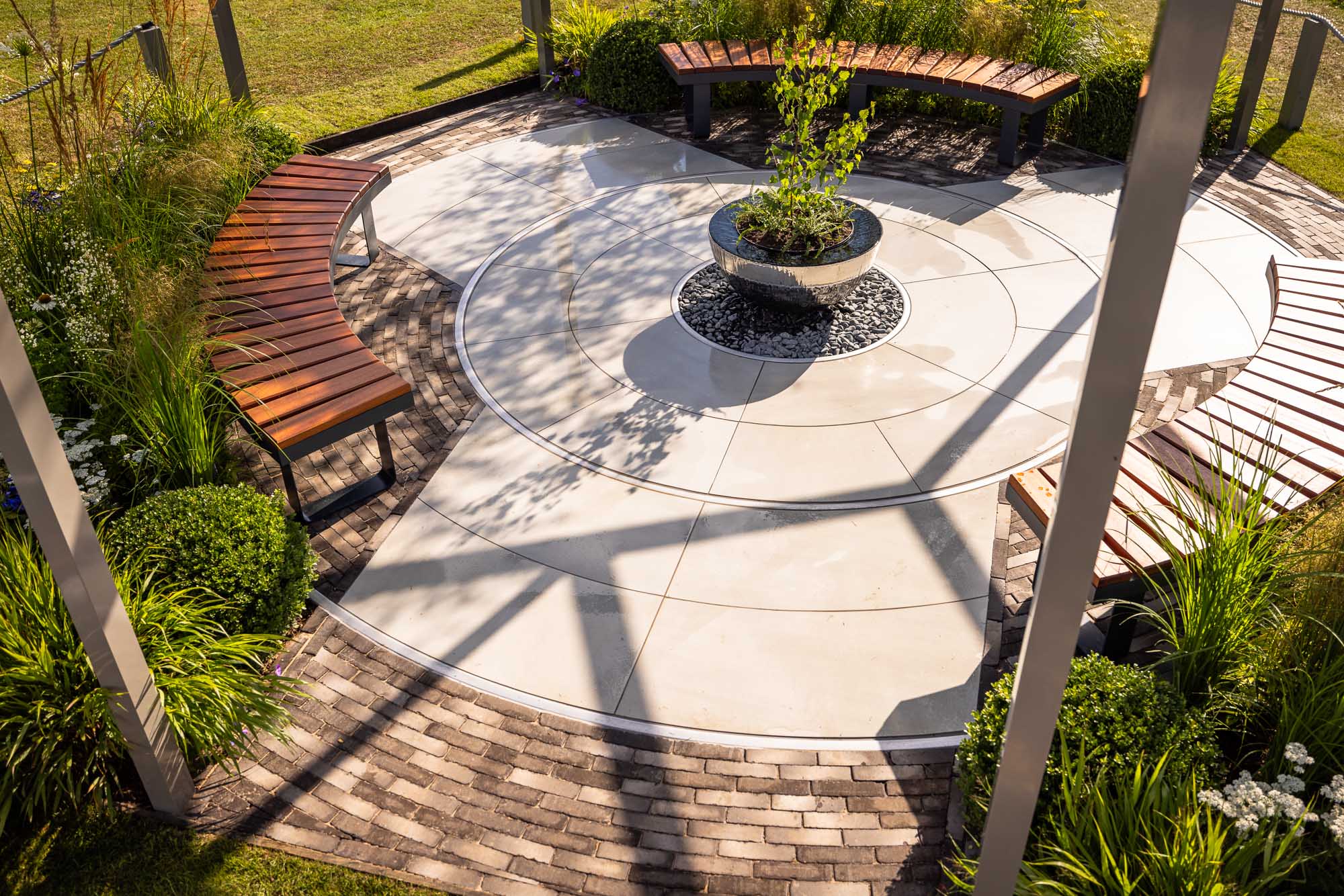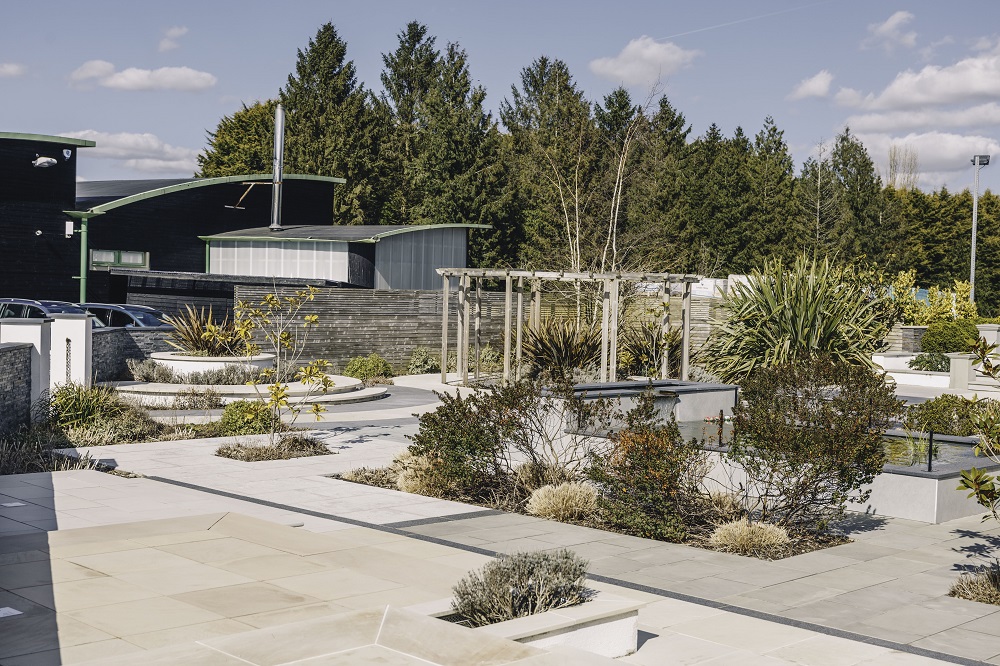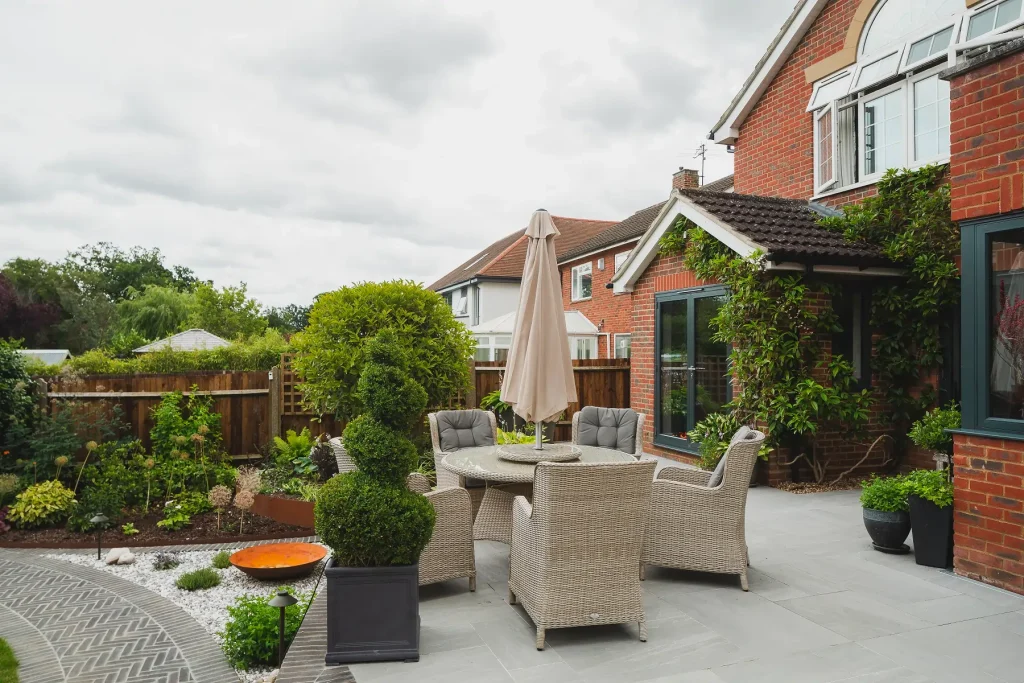The humble sett is one of the oldest forms of paving, yet fits so well into modern gardens. We look at the many ways paving setts can add a little something to your design.
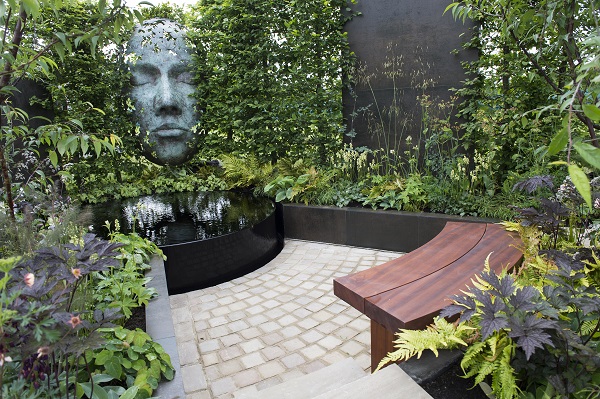
What is a sett?
Setts are small paving blocks, often no bigger than 100x100mm. They can be square or broadly rectangular. In the past, being very hard-wearing, easy to repair, and providing grip for horses' hooves, quarried stone setts were used to pave roads. Nowadays, setts—or cobbles, as they are sometimes called—are mainly used for decorative purposes.
At London Stone we offer both porcelain setts and natural stone. Granite paving setts are a particular favourite for driveways. You’ll often find a whole housefront paved with them. Or you'll see that familiar double line that divides a residential driveway from the pavement. For a more traditional look, our limestone and sandstone setts also fit the bill.
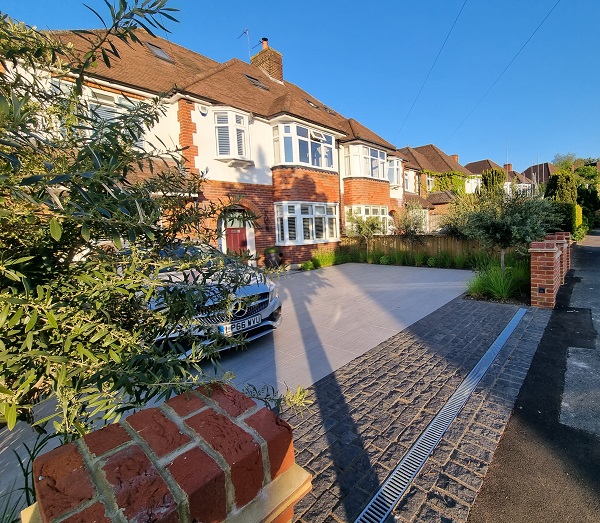
Sandstone setts may be sawn or riven, and may also be tumbled, for a softer look. Some of you will know that sandstone setts, and others in natural stone, can be beset with ethical issues. Rest assured our cobbles are ethically produced. On top of this, London Stone is closely involved No Child Left Behind, a project in the heart of Rajasthan's cobble-producing area, which works with the local community to improve working conditions and get children into full-time education.
Newer to the market, porcelain setts offer a feel that’s similar to sawn sandstone or limestone setts, but are more contemporary. Available in colours from our Project porcelain range, the crisp lines are particularly suited to adding detail.
Small spaces require small paving
Scale and proportion are two important principles in any field of design. Large paving slabs can, surprisingly, make a small space look smaller. Equally the use of small sizes on a large terrace may make the area look busy.
In a small space, the use of small-scale paving will be in proportion to the area, and paving setts laid in a small courtyard can give an intimate feel to the space.
Paving setts for transitions between surfaces
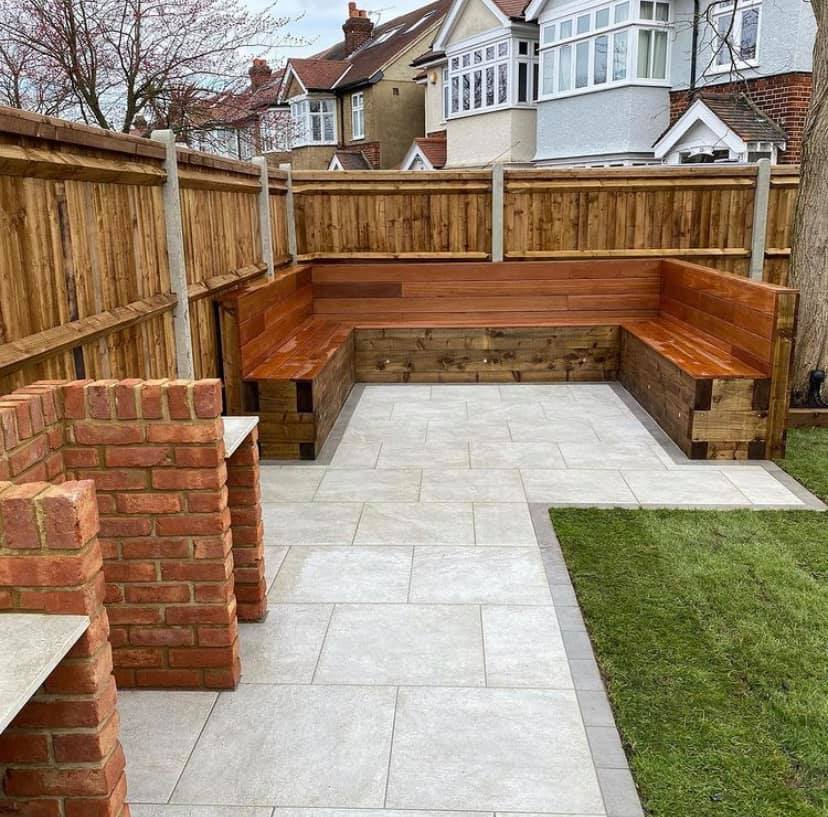
The transition between a paved area and, for example, a lawn or gravel drive has definition when the design includes a single or double row of paving setts. The change in size and texture of paving forms an interesting border.
It’s worth remembering to take care with transitions to gravel or shingle. The finished level of the cobble setts will be crucial to the success of the project. Too high and the setts make a lip, rather than a retaining edge; too low and loose stones spill over into the surrounding areas.
Mowing Strips
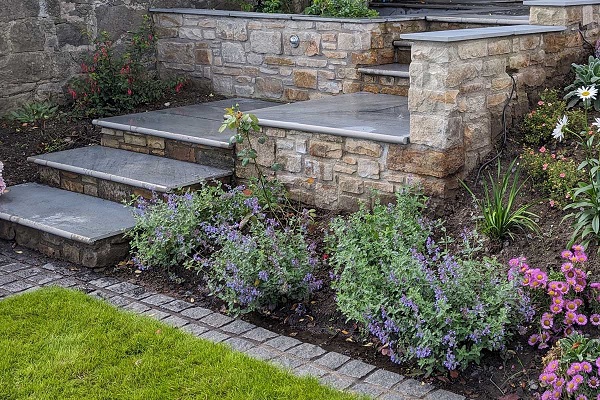
You can make mowing quicker and easier if you lay setts in mowing strips at the edge of a lawn. Gliding the lawn mower over the edge of the lawn, partially over the setts, then leaves a neat edge and removes the need to use shears.
For a real contrast in texture, lay sawn sandstone setts or porcelain setts just below the lowest level of grass cutting. From a design point of view, lighter colour of the setts provides a strong contrast to the green grass. Strong geometric lawn shapes—circles, squares and rectangles—are enhanced by the use of edging.
Creating curves
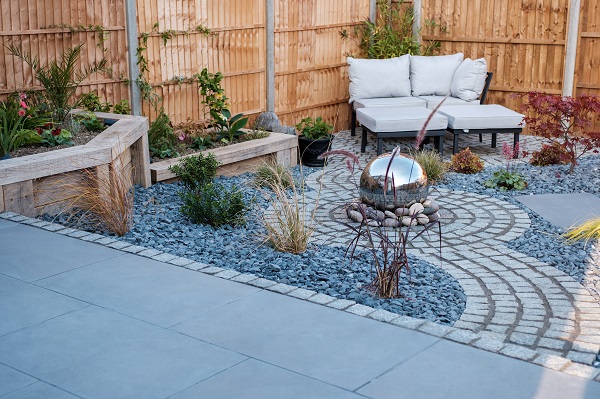
Where paths are designed to be sinuous, pointing gaps between setts can angled so that the path curves to match the design. The tighter the curve the greater the need for laying out the setts in advance, so that the pointing gaps are within acceptable limits.
Paving detail
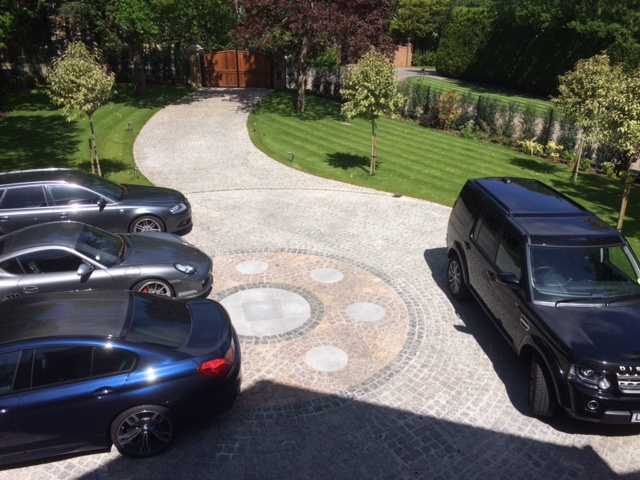
While setts suit small areas, they are an ideal part of a large paving design. Lines of setts can usefully interrupt the flow of large paving slabs, perhaps in a grid pattern, framing areas of paving. Laying them at a 45° angle to the paving looks stunning—however, it requires numerous cuts to the rectangular slabs and will result in wastage.
Paving features
Setts are every bit as useful as a major feature as they are as detailing. At the junction of two paths, a circular feature of paving setts is visually appealing. The circle may fit solely within the area where the two paths cross or extend beyond to make a statement circle. This provides a classic position for a water feature, statue or sculpture. Sett circles may also be used as standalone features within lawns or gravel areas. Here, again, they offer a strong foundation to pieces of art, fountains and pools, or even as an additional seating area.
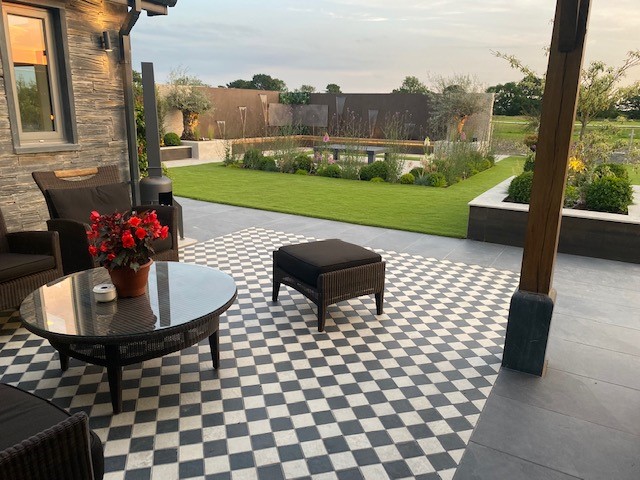
And don’t miss the opportunities given by contrasting colours in our range of granite, sandstone and porcelain setts. Laying two colours in a chequered pattern clearly defines an area, making a focal point.
London Stone supplies granite, sandstone, limestone and porcelain paving setts in a range of colours. While you might be most familiar with this small-size paving as granite driveway setts, its versatility is what will make a good garden design into a great one. At our showrooms you can see for yourself what they look like in combination with larger paving, or click through to individual paving setts on the links above to find more inspirational images.
Post updated: March 2024


/filters:quality(40)/mediadev/media/homepage/price_right_arrow.svg)
/filters:quality(60)/mediadev/media/menu-pics/menu_banner_mobile.png )
/filters:quality(60)/mediadev/media/menu-pics/all-porcelain.jpg )
/filters:quality(60)/mediadev/media/menu-pics/luxury-italian.jpg )
/filters:quality(60)/mediadev/media/menu-pics/premium-italian.jpg )
/filters:quality(60)/mediadev/media/menu-pics/budget-porcelain.jpg )
/filters:quality(60)/mediadev/media/menu-pics/large-format-porcelain.jpg )
/filters:quality(60)/mediadev/media/menu-pics/wood-effect-porcelain.jpg )
/filters:quality(60)/mediadev/media/menu-pics/porcelain-planks.jpg )
/filters:quality(60)/mediadev/media/menu-pics/porcelain-setts.jpg )
/filters:quality(60)/mediadev/media/menu-pics/browse-all-paving.jpg )
/filters:quality(60)/mediadev/media/menu-pics/stone-paving.jpg )
/filters:quality(60)/mediadev/media/menu-pics/interior-tiles.jpg )
/filters:quality(60)/mediadev/media/menu-pics/stone-effect-porcelain.png )
/filters:quality(60)/mediadev/media/menu-pics/wood-effect-porcelain.png )
/filters:quality(60)/mediadev/media/menu-pics/grey-porcelain.png )
/filters:quality(60)/mediadev/media/menu-pics/beige-porcelain.png )
/filters:quality(60)/mediadev/media/menu-pics/dark-porcelain.png )
/filters:quality(60)/mediadev/media/menu-pics/light-porcelain.png )
/filters:quality(60)/mediadev/media/menu-pics/patio-grout.jpg)
/filters:quality(60)/mediadev/media/menu-pics/primers.jpg)
/filters:quality(60)/mediadev/media/menu-pics/porcelain-blades.jpg)
/filters:quality(90)/mediadev/media/menu-pics/drainage.jpg)
/filters:quality(60)/mediadev/media/menu-pics/cleaners.jpg)
/filters:quality(60)/mediadev/media/menu-pics/all-stone-paving.jpg )
/filters:quality(60)/mediadev/media/menu-pics/all-sawn-paving.jpg )
/filters:quality(60)/mediadev/media/menu-pics/all-riven-paving.jpg )
/filters:quality(60)/mediadev/media/menu-pics/indian-sandstone.jpg )
/filters:quality(60)/mediadev/media/menu-pics/limestone-paving.jpg )
/filters:quality(60)/mediadev/media/menu-pics/granite-paving.jpg )
/filters:quality(60)/mediadev/media/menu-pics/slate-paving.jpg )
/filters:quality(60)/mediadev/media/menu-pics/yorkstone-paving.jpg )
/filters:quality(60)/mediadev/media/menu-pics/stone-pavers.jpg )
/filters:quality(60)/mediadev/media/menu-pics/cobbles-setts.jpg )
/filters:quality(60)/mediadev/media/menu-pics/plank-paving.jpg )
/filters:quality(60)/mediadev/media/menu-pics/paving-circles.jpg )
/filters:quality(60)/mediadev/media/menu-pics/bespoke-paving-1.jpg )
/filters:quality(60)/mediadev/media/menu-pics/edging-stones-1.jpg )
/filters:quality(60)/mediadev/media/menu-pics/prestige-stone.jpg )
/filters:quality(60)/mediadev/media/menu-pics/grey-blue-stone.png)
/filters:quality(60)/mediadev/media/menu-pics/swatch-black-dark.jpg )
/filters:quality(60)/mediadev/media/menu-pics/swatch-buff-beige-white.jpg )
/filters:quality(60)/mediadev/media/menu-pics/sealants.jpg)
/filters:quality(60)/mediadev/media/menu-pics/all-clay-paving.jpg )
/filters:quality(60)/mediadev/media/menu-pics/alpha-clay-pavers.jpg )
/filters:quality(60)/mediadev/media/menu-pics/cottage-garden-clay-pavers.jpg )
/filters:quality(60)/mediadev/media/menu-pics/kessel-garden-clay-pavers.jpg )
/filters:quality(60)/mediadev/media/menu-pics/artisan-clay-pavers.jpg )
/filters:quality(60)/mediadev/media/menu-pics/grey-blue-clay-paver.png )
/filters:quality(60)/mediadev/media/menu-pics/red-brown-clay-pavers.png )
/filters:quality(60)/mediadev/media/menu-pics/beige-buff-clay-pavers.png )
/filters:quality(60)/mediadev/media/menu-pics/composite-decking.jpg )
/filters:quality(60)/mediadev/media/menu-pics/designboard-decking.jpg )
/filters:quality(60)/mediadev/media/menu-pics/classic-designboard.jpg )
/filters:quality(60)/mediadev/media/menu-pics/brushed-designboard.jpg )
/filters:quality(60)/mediadev/media/menu-pics/grooved-designboard.jpg )
/filters:quality(60)/mediadev/media/menu-pics/millboard-decking.jpg )
/filters:quality(60)/mediadev/media/menu-pics/grey-decking.jpg )
/filters:quality(60)/mediadev/media/menu-pics/black-charcoal-decking.jpg)
/filters:quality(60)/mediadev/media/menu-pics/brown-decking.jpg)
/filters:quality(60)/mediadev/media/menu-pics/all-build-deck.png )
/filters:quality(60)/mediadev/media/menu-pics/stone-cladding.jpg )
/filters:quality(60)/mediadev/media/menu-pics/all-garden-walling-1.jpg )
/filters:quality(60)/mediadev/media/menu-pics/facing-bricks.jpg )
/filters:quality(60)/mediadev/media/menu-pics/garden-screening.jpg )
/filters:quality(60)/mediadev/media/menu-pics/all-steps-coping.jpg )
/filters:quality(60)/mediadev/media/menu-pics/stone-garden-steps.jpg )
/filters:quality(60)/mediadev/media/menu-pics/sawn-steps.jpg )
/filters:quality(60)/mediadev/media/menu-pics/riven-steps.jpg )
/filters:quality(60)/mediadev/media/menu-pics/yorkstone-steps.jpg )
/filters:quality(60)/mediadev/media/menu-pics/bespoke-steps.jpg )
/filters:quality(60)/mediadev/media/menu-pics/porcelain-steps.jpg )
/filters:quality(60)/mediadev/media/menu-pics/off-the-shelf.jpg )
/filters:quality(60)/mediadev/media/menu-pics/stone-coping.jpg )
/filters:quality(60)/mediadev/media/menu-pics/sawn-coping.jpg )
/filters:quality(60)/mediadev/media/menu-pics/riven-coping.jpg )
/filters:quality(60)/mediadev/media/menu-pics/yorkstone-coping.jpg )
/filters:quality(60)/mediadev/media/menu-pics/bespoke-coping.jpg )
/filters:quality(60)/mediadev/media/menu-pics/stone-pier-caps.jpg )
/filters:quality(60)/mediadev/media/menu-pics/porcelain-coping.jpg )
/filters:quality(60)/mediadev/media/menu-pics/all-bespoke-services.jpg )
/filters:quality(60)/mediadev/media/menu-pics/bespoke-paving-2.jpg )
/filters:quality(60)/mediadev/media/menu-pics/bespoke-steps-1.jpg )
/filters:quality(60)/mediadev/media/menu-pics/bespoke-coping-1.jpg )
/filters:quality(60)/mediadev/media/menu-pics/edge-profiles.jpg )
/filters:quality(60)/mediadev/media/menu-pics/masonry-services.jpg )
/filters:quality(60)/mediadev/media/menu-pics/deluxe-pergolas.jpg )
/filters:quality(60)/mediadev/media/menu-pics/proteus-pergolas.jpg )
/filters:quality(60)/mediadev/media/menu-pics/menu_Garden_banner_desk.png )
/filters:quality(60)/mediadev/media/menu-pics/corten_planter_menu.png )
 Trade Discount Available
Trade Discount Available FREE Nationwide Delivery
FREE Nationwide Delivery Nationwide Showrooms
Nationwide Showrooms Live Stock Levels
Live Stock Levels Split Packs Available
Split Packs Available